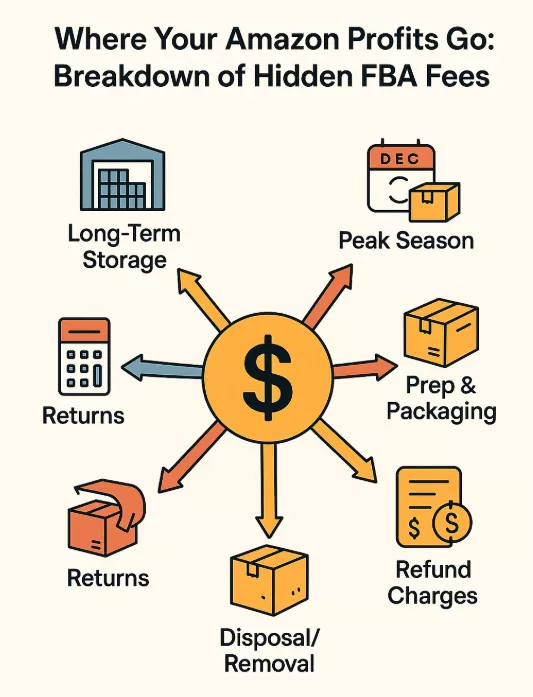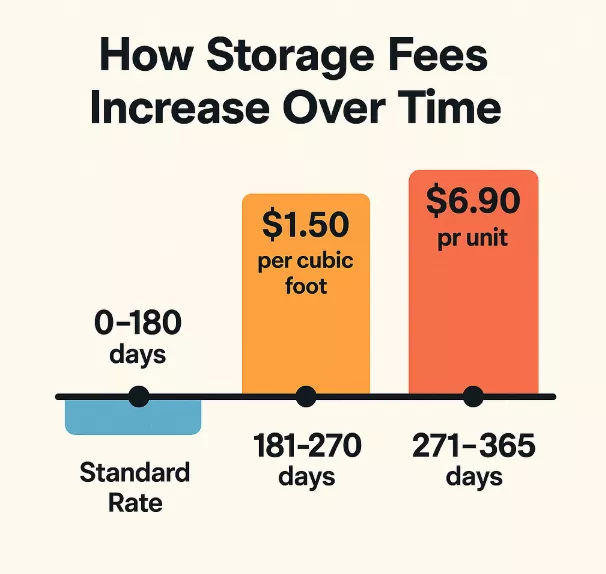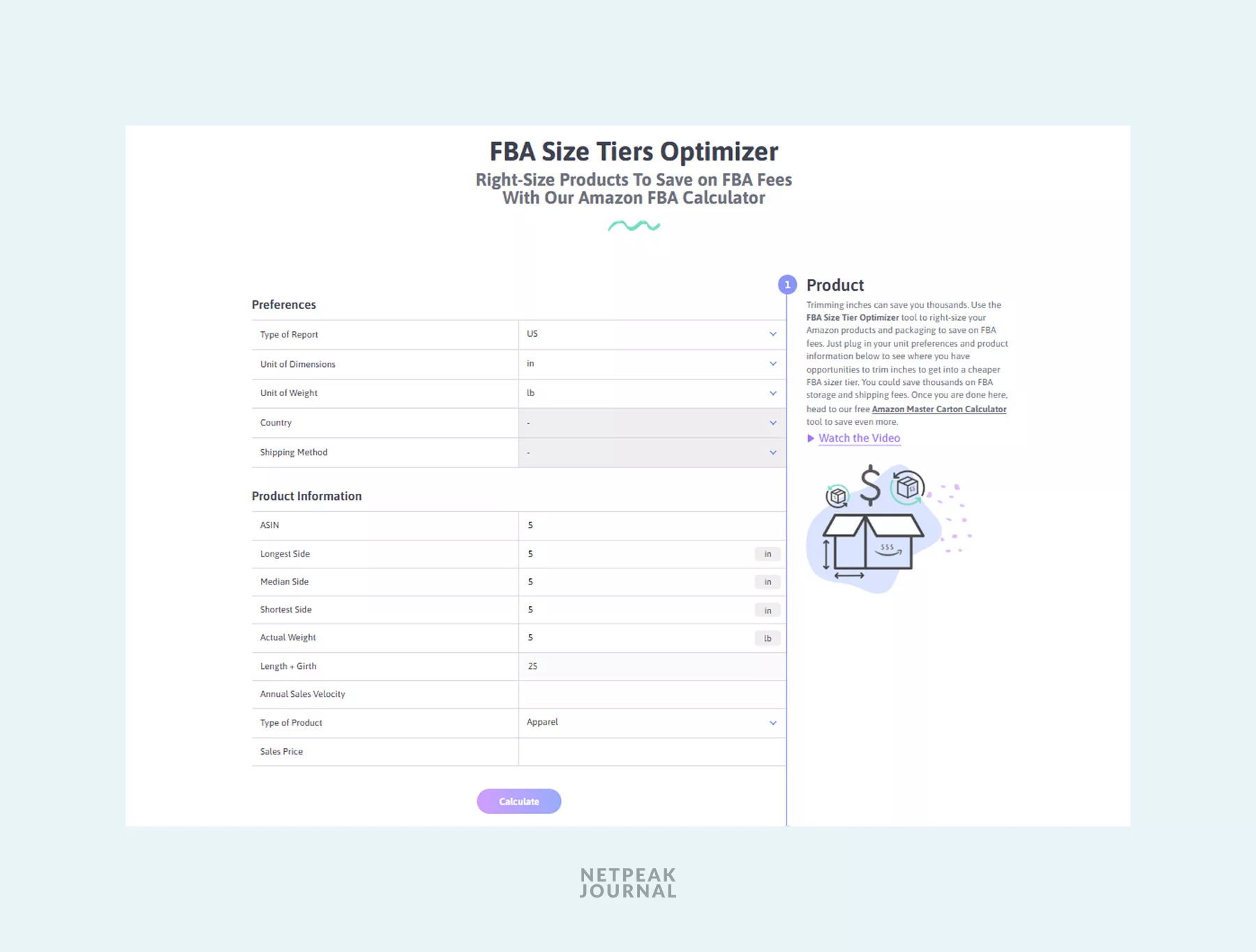Amazon sellers often think they’ve got their margins figured out, then Amazon hits them with a fee they never saw coming. It’s like playing poker with a dealer who keeps adding new cards to the deck.
Ready to slash your Amazon FBA costs? Get expert guidance on fee optimization.
Here’s the real deal: There are no hidden fees on Amazon, but there are many. And “many” is an understatement when Amazon fees can devour 30%–50% of revenue faster than sellers can say “Fulfillment by Amazon.”
The fees change every day, and FBA is essentially the goose that lays the golden egg — but only if sellers know how to keep that goose fed without bankrupting themselves. Amazon isn’t just an e-commerce company; it’s a logistics behemoth with more than 2 million employees, 70% of whom are drivers or fulfillment workers. There’s even a South Park episode about Amazon being a logistics monopoly (shhhh, don’t tell Jeff).
The convenience for customers means fees for sellers, and that’s where the real business pain starts for anyone selling on Amazon’s marketplace.
Amazon FBA Hidden Costs Explained
Long-Term Storage Fees: The Inventory Graveyard
Selling Halloween costumes with December arriving, and you still have a warehouse full of zombie masks. Congratulations — that’s entering Amazon’s aged inventory surcharge zone. After 181 days, Amazon starts charging $1.50 per cubic foot, escalating to $3.80 between 271–365 days, and then a whopping $6.90 per unit (not per cubic foot) after 365 days.
Pro tip: Set up automatic removal of goods before they hit these milestones. Halloween items still sitting in February? Time to say goodbye. Understanding the full cost structure includes knowing when to cut losses.
Shipping Inventory Costs: The Split Shipment Trap
Amazon might decide a single shipment needs to go to California, Texas and New York. Surprise! Multiple shipping fees incoming. The FBA inbound placement service fees range from $0.27 to $1.58 per unit, and for products in the $10–$15 range, shipping can absolutely destroy margins.
The solution? Send one big package once instead of 10 smaller packages each month. Avoid split shipping like the plague — your profit margins will thank you.
Peak Season Fulfillment Fees: Holiday Highway Robbery
October through December, Amazon cranks up storage fees from $0.69 to $2.40 per cubic foot. It’s like surge pricing for warehouses. The peak season fulfillment fees hit hardest during Q4 when sellers need Amazon most.
Labeling, Prepping and Packaging Costs: The Devil’s in the Details
Amazon has strict rules about everything. Liquid glass bottles? Amazon might decide they need repackaging to avoid breakage — and they’ll charge $0.30 per unit for labeling services. Follow Amazon’s packaging guidelines religiously, because repackaging can be the most expensive fee sellers never saw coming.
Weight matters too: If products get wet in transit and become heavier, Amazon factors in the new weight. Products over 50 pounds require “Team Lift” labels for multiple workers to handle. Monitor listings regularly — even a one-inch dimension change can crush your margins.
Returns Processing Fees: The Boomerang Effect
Returns are inevitable, especially in fashion (nearly 30% return rate) and electronics. Amazon charges return processing fees ranging from $2.12 to $6.85 per unit for high-return categories like apparel, jewelry, shoes and handbags. Beauty products and electronics see particularly high return rates because the item condition often prevents reselling.
Strategic insight: Improve size charts for clothing, and enhance product listings with detailed descriptions. Customer reviews and messages are goldmines for identifying return patterns.
Low Inventory or Overstocking Costs: The Goldilocks Problem
Too little inventory? Amazon lowers search ranking — sellers can have the best listing in the world, but if they’re out of stock, it won’t matter. Too much inventory? Hello, long-term storage fees. It’s a dual penalty system that requires precise inventory forecasting.
Amazon will literally hide products in search results if inventory levels are low. Monitor inventory levels closely and plan for replenishment, especially during high-demand periods.
Disposal or Removal Fees: The Final Goodbye
When food and cosmetics expire or products become unsellable, Amazon charges per unit for removal and destruction. It’s often cheaper to have Amazon handle disposal automatically rather than shipping expired goods back.
Refund Administration Charges: The 20% Bite
For non-media products, when issuing a refund, Amazon keeps 20% of related fees (up to $5 per line item). Media products like books and DVDs get full fee refunds, but everything else gets hit with the refund administration fee.
Amazon FBA Fee Summary Table (2025)
|
Fee Type |
Details |
Typical Range |
|
Referral Fee |
% of item price (varies by category) |
6% – 45% |
|
FBA Fulfillment Fee |
Based on size & weight (per unit) |
$3.22 – $200+ |
|
Monthly Storage Fee |
Charged per cubic foot (Jan–Sep / Oct–Dec) |
$0.75 – $2.40 |
|
Aged Inventory Surcharge |
Kicks in after 181 days in storage |
$1.50 → $6.90 per unit |
|
Returns Processing Fee |
For apparel, footwear, and high-return categories |
$2.12 – $6.85 per return |
|
Removal/Disposal Fees |
Per unit, based on size/weight |
$0.50 – $1.90 |
|
Labeling Fee |
If Amazon applies barcodes |
$0.30 per unit |
|
Prep Service Fee |
For bagging, bubble wrap, taping, etc. |
$1.00 – $2.30+ per unit |
|
Refund Administration Fee |
Amazon retains part of fees on refunds (non-media items) |
20% of referral fee (max $5) |
|
Inbound Placement Service Fee |
For split shipments to different warehouses |
$0.27 – $1.58 per unit |
|
Subscription Fee |
For Professional selling plan |
$39.99/month |
Note: Amazon fees — including referral commissions, storage, and fulfillment rates — may vary by region (e.g., US vs. EU vs. UK). Always check the local Amazon marketplace for the most accurate information.
-
Amazon Fulfillment Fee Rates (FBA Fees Overview)
This page outlines current FBA fulfillment, storage, labeling, prep, and removal fees by item size and category. -
Amazon Referral Fee Rates by Category
Here you can find the up-to-date referral fee percentage by product category (e.g., 15% for most categories, 8% for electronics, 45% for accessories, etc.).
Best Practices for Managing FBA Costs
Optimizing Inventory for FBA
Track every SKU. If you can’t measure it, you can't control it.” Use Amazon’s seller dashboard to view inventory age and excess levels. Large inventories actually work to advantage because goods can be distributed across multiple fulfillment centers, reducing shipping costs.
Adjusting Product Listings
Weight audits are crucial. A mattress in a vacuum bag weighs drastically less than an expanded one. Optimize packages for dimensions and weight — small changes in product specifications can significantly impact fees.
Amazon’s Fee Structure Changes: The Moving Target
Like everything else, fees get more expensive every year. Sometimes it’s not just Amazon charging — governments can impose eco fees or other surcharges. Monitor Amazon fee updates and adjust Amazon pricing strategy accordingly.
Price decreases are not equal to price increases, so increase prices strategically throughout the year to maintain your margins.
Proactive FBA Strategy
Set up automated inventory reports. Amazon can send messages about inventory levels, but proactive monitoring prevents costly surprises. Forecast sales and reinforce inventory planning.
How to Avoid Amazon Hidden FBA Fees With 3PL Solutions
Sometimes FBM (Fulfillment by Merchant) or third-party logistics (3PL) partners can be much cheaper than FBA, especially for custom bundles or products with specific storage requirements. However, remember that Amazon reduces FBM listings in search results, so weigh visibility against cost savings.
3PL solutions work particularly well for:
-
Custom product bundles
-
Oversized items with high storage fees
-
Products with specific handling requirements
-
Businesses wanting to reduce Amazon dependency
Compare fees across different fulfillment methods for each product category. What works for electronics might not work for apparel.
Useful Tools to Calculate Amazon Fees
Essential Calculators
The SoStocked Amazon FBA calculator provides comprehensive fee breakdowns. Additionally, consider:
-
Amazon’s native fee calculator in Seller Central
-
Helium 10’s profitability calculator
-
Jungle Scout’s fee estimation tools
-
SellerApp’s FBA calculator
These tools help model different scenarios and understand the true impact of fee changes on the bottom line.
Strategic Solutions for FBA Fee Management
What Niche-Specific Factors Matter?
Fees vary dramatically by niche. Fashion faces high return rates, electronics deal with packaging complexity and consumables battle expiration dates. Different fee structures apply to each product category because what works for beauty brands won’t work for home goods.
The Strategic-Level Solution
The key is treating FBA costs as a variable cost that requires active management, not a fixed expense to simply accept. This means:
-
Dynamic pricing that accounts for seasonal fee changes
-
Inventory turnover optimization based on storage fee thresholds
-
Return rate reduction through improved listing optimization
-
Packaging standardization to avoid surprise prep fees
Services interconnect because understanding the full cost structure from day one is crucial, not discovering it piece by piece when starting to sell on Amazon.
Execution Breakdown
Month 1–2: Audit current fee structures and set up monitoring systems
Month 3–4: Implement inventory optimization and packaging standardizationMonth 5–6: Develop dynamic pricing strategies based on fee fluctuations
Ongoing: Monthly fee analysis and quarterly strategy adjustments
Success metrics include reduced storage fees as a percentage of revenue, improved inventory turnover ratios and decreased return processing costs.
Advanced Fee Reduction Tactics
Use Amazon’s seasonality against itself. Ship inventory in September before peak season fees kick in, but not so much that it hits long-term storage penalties.
Game the weight system. Package products to just under weight thresholds. A 1.9-pound item ships cheaper than a 2.1-pound item in many categories.
Leverage removal timing. Schedule removal orders during Amazon’s less busy periods when they offer occasional fee discounts.
Bundle strategically. Sometimes combining slow-moving items with fast-sellers in bundles helps move aged inventory before storage fees accumulate.
The reality is that successful Amazon sellers don’t just sell products — they manage a complex logistics and fee optimization operation. Those who treat FBA costs as an afterthought are the ones posting on Reddit about razor-thin margins.
Turning Fee Management Into Competitive Advantage
Amazon FBA costs are like death and taxes — inevitable and always increasing. But unlike death and taxes, sellers can actually do something about FBA hidden fees with proper planning and strategy.
The business pain is real: Margins getting squeezed by an ever-expanding fee structure that changes faster than the ability to adapt. The solution isn’t avoiding Amazon — it’s mastering the fee game better than the competition.
Remember, convenience for customers means fees for sellers, but smart Amazon sellers turn that equation into profit by building fee management into their core business strategy. When understanding that FBA is the goose that lays the golden egg, the goal isn’t to eliminate fees — it’s to make sure those fees are worth every penny.
Whether comparing different platforms or optimizing current Amazon presence, understanding the true cost structure is non-negotiable for sustainable success in e-commerce. Smart Amazon pricing strategy incorporates all fee considerations.
Transform your Amazon FBA strategy today. Contact the Netpeak Agency for expert fee optimization.
FAQ
Why are FBA fees so high?
Amazon’s FBA fees reflect the true cost of operating the world’s most sophisticated logistics network. With 2-plus million employees and global infrastructure, Amazon charges premium prices for premium service. The fees also help Amazon maintain profit margins while providing sellers access to Prime customers and advanced fulfillment capabilities.
What are the other costs of Amazon FBA?
Beyond standard FBA fees, sellers face referral fees (6%–45% by category), advertising costs (typically 10%–30% of revenue), account subscription fees ($39.99/month for Professional) and various service fees for returns, removals and special handling. Hidden costs include opportunity costs from inventory restrictions and pricing limitations.
How do I minimize FBA fees?
Minimize FBA costs through strategic inventory management, optimized packaging and proactive monitoring. Use fee calculators before listing products, maintain optimal inventory levels to avoid storage penalties and improve listings to reduce return rates. Consider hybrid fulfillment strategies using both FBA and FBM based on product profitability.
Related Articles
Segments vs. Audiences in Google Analytics 4: A Comprehensive Setup Guide
You will learn how to correctly set up custom audiences, allowing you to save time and gain insight into your audience
PPC for E-commerce: How to Buy Attention Without Going Broke
Learn how PPC for e-commerce can drive fast sales for your store without draining your budget. Smart strategies, beginner tips, and proven ways to scale profitably.
Personalization 2.0: Breaking the Deadlock of Cold Newsletters
Most leads in managerial positions receive dozens of similar messages every day. Below, I will present the algorithms and techniques that increased our partners' campaign conversion rates from 1% to 11%






